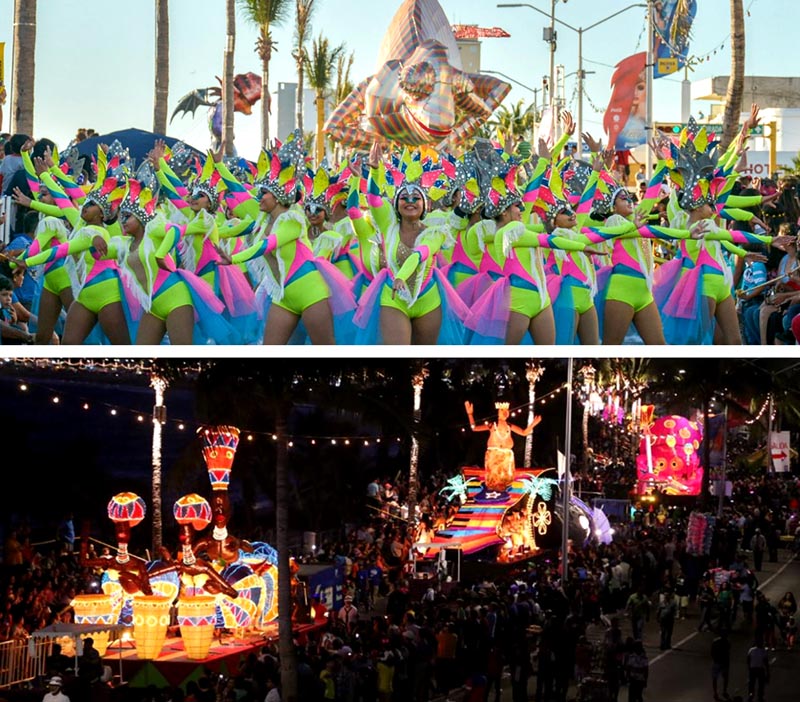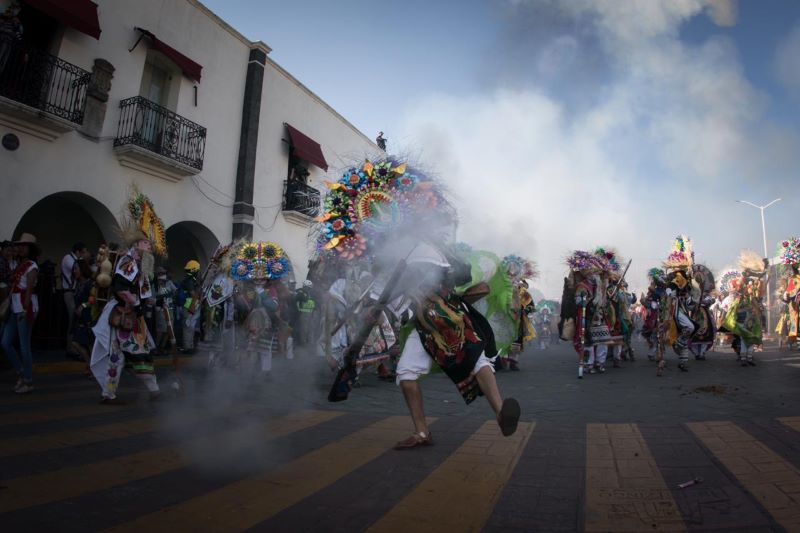Step into a world filled with color, music, and joy as you immerse yourself in Mexico’s vibrant carnival traditions. From the lively parades to the elaborate costumes, these festive celebrations are a kaleidoscope of culture and heritage. Indulge in the excitement and revelry as you discover the rich historical significance and unique traditions that make Mexico’s carnival season a truly unforgettable experience.
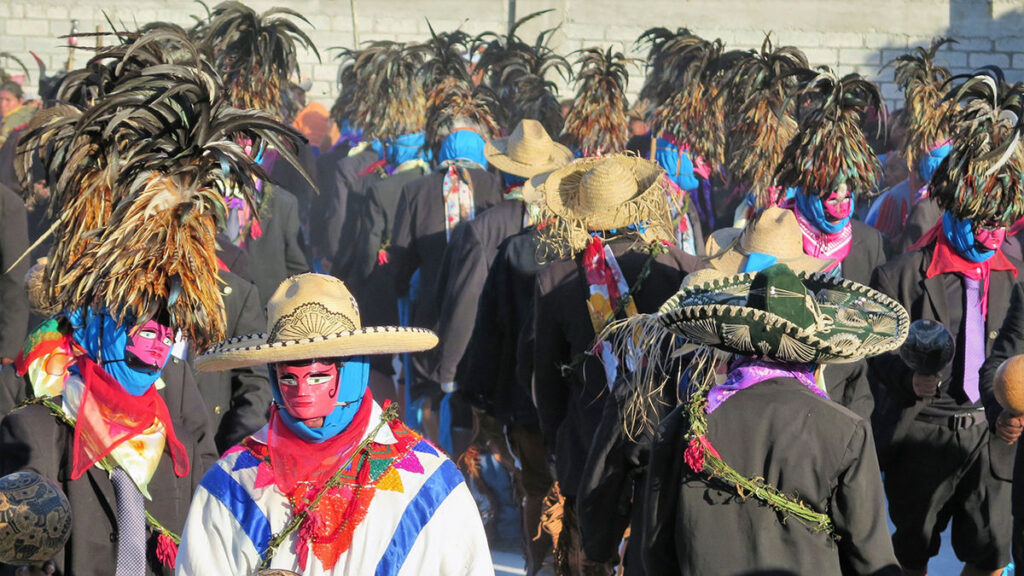
The History of Mexican Carnivals
Pre-Hispanic Origins
Mexican carnivals have a rich history that dates back to pre-Hispanic times. Indigenous civilizations such as the Aztecs, Mayans, and Olmecs had their own unique traditions and celebrations, many of which revolved around honoring their gods, agricultural fertility, and the changing of seasons. These rituals often included dance, music, and colorful costumes, creating the foundations for the vibrant and lively Mexican carnivals we know today.
Influence of Spanish Colonialism
With the arrival of Spanish conquistadors in the 16th century, the cultural landscape of Mexico underwent a significant transformation. The Spanish introduced Catholicism as the dominant religion, blending it with the existing indigenous traditions. This fusion of cultures greatly influenced Mexican carnival celebrations, infusing them with Catholic rituals, religious processions, and Christian symbolism. The Spanish colonizers also brought their own love for music, dance, and masquerades, which further shaped the evolution of Mexican carnivals.
Evolution of Carnival Celebrations
Over the centuries, Mexican carnivals have evolved and adapted to the changing social and cultural dynamics of the country. The blending of indigenous and Spanish traditions gave birth to a unique and diverse carnival culture in Mexico. Each region developed its own distinct style of celebration, incorporating local customs, music, and dance. Today, Mexican carnivals are a vibrant reflection of the country’s rich history, cultural diversity, and creative spirit.
Famous Carnivals in Mexico
Carnaval de Veracruz
One of the most famous and oldest carnivals in Mexico is the Carnaval de Veracruz. Dating back to the 19th century, this carnival is a true celebration of music, dance, and joy. The streets of Veracruz come alive with extravagant parades, colorful costumes, and energetic music. The main attraction is the crowning of the Carnival Queen, who leads the procession in a regal fashion, accompanied by her court of beautifully dressed ladies. The Carnaval de Veracruz is not only a major tourist attraction but also an important cultural event for the local population.
Carnaval de Mazatlán
In the coastal city of Mazatlán, the Carnaval de Mazatlán takes center stage as one of Mexico’s most renowned carnival celebrations. Dating back to 1898, this carnival draws thousands of visitors each year with its blend of tradition, rhythm, and beachside festivities. One of the highlights of the Carnaval de Mazatlán is the El Quema del Mal Humor (The Burning of Bad Mood), where a giant papier-mâché figure representing a hated public figure is set ablaze, symbolizing the elimination of negativity and the start of a joyful celebration.
Carnaval de Mérida
The city of Mérida in the Yucatán Peninsula is home to the vibrant Carnaval de Mérida. This carnival showcases the region’s unique blend of indigenous and Spanish influences. The streets of Mérida come alive with live music, traditional dances, and colorful parades featuring elaborately decorated floats and groups of costumed revelers. The carnival also incorporates regional traditions such as the “Vaquería” dance, which pays homage to the Yucatán’s rich cowboy heritage. The Carnaval de Mérida is a true celebration of Yucatecan pride and cultural identity.
Colorful Costumes and Masks
Traditional Mexican Costumes
Mexican carnival costumes are a visual feast for the eyes, featuring an array of vibrant colors, intricate embroidery, and luxurious fabrics. Each region has its own traditional costumes, reflecting the unique cultural heritage of the area. For example, in Veracruz, women wear the “jarocho” dress, with its wide skirt, ruffled blouse, and colorful ribbons. In Mazatlán, outfits often incorporate elements of marine life, such as seashells and fish scales. These traditional costumes not only add to the visual spectacle of the carnivals but also serve as a way to preserve and showcase Mexico’s cultural traditions.
Symbolism in Carnival Masks
Masks have played a significant role in Mexican carnival celebrations since ancient times. They serve as a way for participants to transform themselves into different characters, representing mythical creatures, animals, or even revered historical figures. The masks serve as a disguise, allowing people to let go of their inhibitions and fully embrace the festive spirit of the carnival. Each mask carries its own symbolism, reflecting cultural beliefs, spiritual connections, and personal expressions of identity. The intricate designs and vibrant colors of the masks add to the overall visual allure of the carnival.
Elaborate Feather Headdresses
Feathers are an integral part of Mexican carnival costumes, particularly in regions with indigenous influences. Elaborate feather headdresses, known as “penachos,” are worn by participants to add a touch of grandeur and symbolism to their outfits. The feathers come from various native bird species, such as macaws and quetzals, and are meticulously arranged to create stunning displays of color and texture. These feather headdresses not only enhance the visual appeal of the carnival but also pay homage to the indigenous traditions and the connection between humans and nature.
Traditional Music and Dance
Sones and Huapangos
Music is the lifeblood of Mexican carnival celebrations, providing an infectious rhythm that keeps the festivities alive. The traditional music genres of sones and huapangos are often featured during carnivals. Sones are lively and energetic songs that showcase the unique regional styles and instruments, such as the jarana, guitar, and accordion. Huapangos, on the other hand, are known for their fast-paced rhythm and intricate footwork, making them ideal for dance performances. The combination of these traditional musical styles sets the stage for lively dancing and exuberant celebrations.
Zapateado: The Art of Foot-Tapping
Zapateado is a traditional Mexican dance style that involves fast and rhythmic foot-tapping. This dance form is often performed during carnival celebrations, adding to the lively atmosphere. Participants wear special shoes with nails or metal taps on the soles, which create a distinctive percussive sound as they tap and stomp in time with the music. Zapateado requires precision, coordination, and agility, making it a captivating spectacle for both participants and spectators. This unique dance form embodies the dynamic spirit of Mexican carnivals and has become a cherished tradition across the country.
Folkloric Dance Troupes
Folkloric dance troupes, known as “ballet folklórico,” are a prominent feature of Mexican carnivals. These troupes perform traditional dances that reflect the diverse regional cultures and ethnicities of Mexico. Each region has its own unique dances, costumes, and music, showcasing the rich tapestry of Mexican heritage. During carnivals, these dance troupes take center stage, enchanting audiences with their synchronized movements, colorful costumes, and intricate choreography. The performances serve as a visual representation of Mexico’s cultural diversity and help in preserving and promoting traditional dance forms.
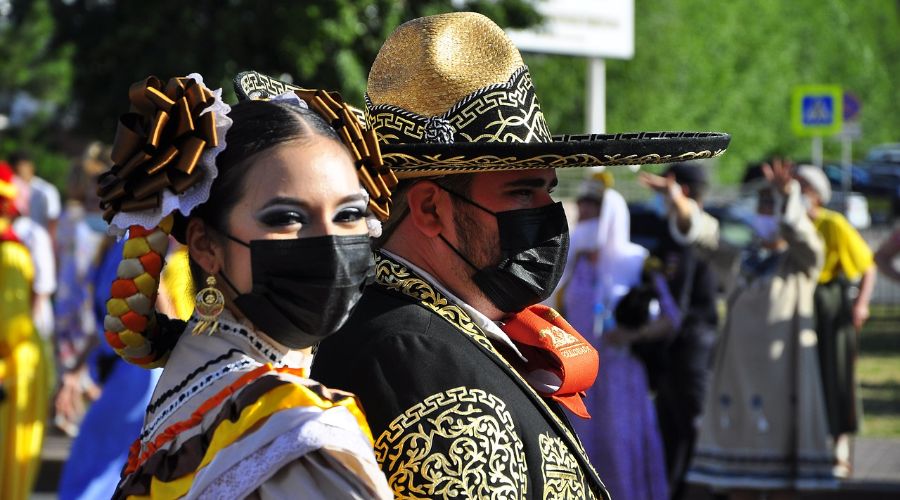
Street Parades and Floats
El Paseo de los Locos
One of the highlights of Mexican carnivals is the spectacular street parades that take place in various cities and towns across the country. El Paseo de los Locos, which translates to “The Parade of the Crazies,” is a lively and vibrant procession that showcases the creativity and imagination of the participants. People of all ages dress up in elaborate costumes, often portraying whimsical characters or cultural icons. The parade winds through the streets, accompanied by live music, dancing, and cheering onlookers. El Paseo de los Locos is a celebration of individuality, self-expression, and the joy of coming together as a community.
El Desfile de las Flores
El Desfile de las Flores, or “The Flower Parade,” is a visually stunning spectacle that combines the beauty of nature with the joyous spirit of carnival. Floats adorned with vibrant and fragrant flowers make their way through the streets, mesmerizing spectators with their intricate designs and captivating aromas. The floats often depict scenes from Mexican folklore, historical events, or simply showcase the boundless creativity of the participants. El Desfile de las Flores is a celebration of Mexico’s rich flora and fauna, paying homage to the country’s natural beauty.
El Desfile del Rey Momo
El Desfile del Rey Momo, also known as “The Parade of King Momo,” is a grand procession that marks the culmination of many Mexican carnivals. King Momo, a ceremonial figure representing the spirit of revelry, leads the parade aboard a lavishly decorated float. The parade features participants in elaborate costumes, music bands, dance troupes, and colorful floats. People line the streets to catch a glimpse of the spectacle, sing along to lively tunes, and be a part of the contagious energy. El Desfile del Rey Momo is a joyous and exuberant celebration that marks the official end to the carnival season.
Traditional Foods and Drinks
Tamales
No Mexican carnival celebration is complete without traditional foods, and tamales are a staple in these festive gatherings. Tamales are made from masa (corn dough) and filled with various ingredients, such as meat, cheese, or vegetables. The filling is then wrapped in a corn husk and steamed, resulting in a soft and flavorful treat. Tamales are often prepared in large quantities and shared among family, friends, and neighbors during carnival celebrations. These delicious delicacies not only satiate hunger but also represent the unity and shared joy experienced during the festivities.
Chiles en Nogada
Chiles en Nogada is a traditional Mexican dish that holds great significance during carnival celebrations. This dish features roasted poblano peppers stuffed with a mixture of ground meat, fruits, nuts, herbs, and spices. The peppers are then covered with a creamy walnut sauce and garnished with pomegranate seeds and parsley, creating a vibrant display of colors. Chiles en Nogada is not only a gastronomic delight but also a symbol of Mexican national pride due to its incorporation of the colors of the Mexican flag – green, white, and red. It is often enjoyed during special occasions and festivities, including carnivals.
Ponche Navideño
Carnival celebrations often coincide with the Christmas season in Mexico, and one traditional beverage that adds to the festive atmosphere is Ponche Navideño. This warm and aromatic punch is made by simmering fruits such as apples, pears, oranges, and tejocotes (a native fruit) with spices like cinnamon and cloves. The punch is sweetened with cane sugar and often spiked with a touch of rum or tequila for those seeking a little extra merriment. Ponche Navideño warms the soul and brings a sense of comfort during the cooler months, making it a beloved drink during Mexican carnival festivities.
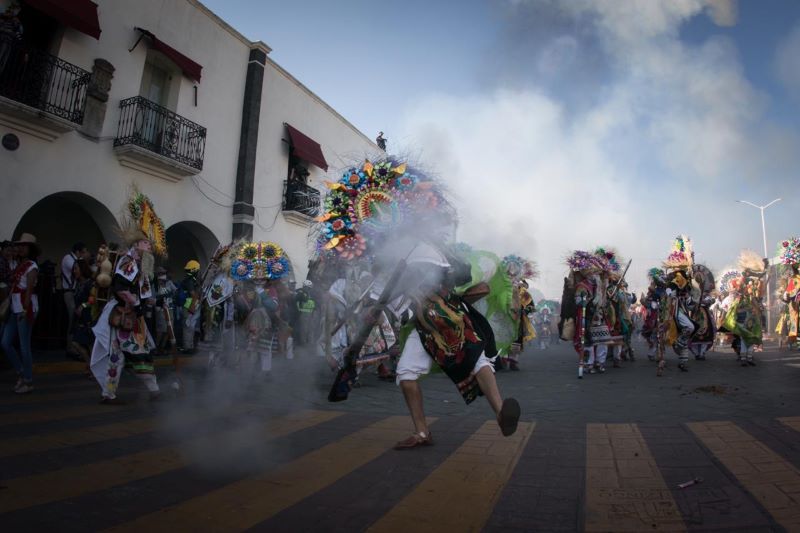
Religious Significance and Traditions
Intertwining of Indigenous Beliefs
Mexican carnivals bear witness to the intertwining of indigenous beliefs and Catholic traditions, creating a unique blend of spirituality and celebration. Many of the rituals and customs incorporated into the carnival celebrations have deep roots in ancient indigenous practices. For example, the reverence for nature, the worship of ancestral deities, and the belief in the cyclical cycle of life and death are elements that continue to permeate Mexican carnival traditions. This fusion of beliefs allows participants to honor their ancestors, connect with the natural world, and celebrate the continuity of life.
The Role of Catholicism
With the arrival of Spanish colonizers and the introduction of Catholicism, Mexican carnivals adopted elements of the Catholic faith, adding another layer of significance and ritual. Christian symbols such as crosses, saints, and religious processions became intertwined with the existing indigenous traditions. The Catholic influence is particularly evident in the various processions and rituals that take place during carnivals, including the reenactment of biblical stories, public displays of religious statues and icons, and the involvement of local churches in the festivities. The harmonious coexistence of indigenous and Catholic beliefs adds depth and spirituality to the carnival celebrations.
Rituals and Processions
Carnivals in Mexico are not just about revelry and merrymaking; they also include solemn rituals and processions that reflect the spiritual essence of the celebrations. These rituals often take place in churches, town squares, or sacred sites, gathering participants and spectators for moments of reflection and prayer. Processions may involve carrying religious statues through the streets, accompanied by music, incense, and the heartfelt devotion of the faithful. These rituals provide an opportunity for participants to express their faith, seek blessings, and give thanks for a bountiful harvest, good health, or other intentions. The integration of rituals and processions into Mexican carnivals showcases the deep-rooted spiritual connection of the people with their religious beliefs.
Children’s Carnival Celebrations
Carnavalito
Children are not left out of the carnival celebrations in Mexico. Carnavalito, meaning “little carnival,” is a special event dedicated to the young revelers. Children dress up in colorful costumes, resembling their favorite superheroes, princesses, animals, or mythical characters. They take part in mini parades, dance to lively music, and engage in games and activities organized especially for them. Carnavalito instills a sense of joy, imagination, and camaraderie among children, allowing them to fully embrace the fun and excitement of Mexican carnivals. This tradition ensures that the vibrant carnival culture is passed on to future generations.
Piñatas and Candy Showers
Piñatas are an integral part of Mexican celebrations, and carnivals are no exception. These brightly colored, paper-mâché figures filled with sweets and treats are hung from above and broken open by blindfolded participants, who take turns striking them with a stick. Once the piñata is shattered, candy and small toys shower down, creating a delightful frenzy as children scramble to collect their treasures. The tradition of piñatas during carnivals not only brings joy to children but also symbolizes the breaking of barriers, the triumph of good over evil, and the sharing of abundance.
Miniature Parade Floats
Children also have the opportunity to showcase their creativity by designing and building miniature parade floats for carnivals. These floats are often made from cardboard, paper, or other materials and are adorned with colorful decorations. Children work together in schools or community groups to create their floats, reflecting their interests, themes, or cultural references. These miniature floats are then showcased in a special Children’s Parade, allowing young participants to experience the excitement of being a part of the larger carnival celebrations. This tradition nurtures the artistic talents and teamwork skills of children while instilling a sense of pride and accomplishment.
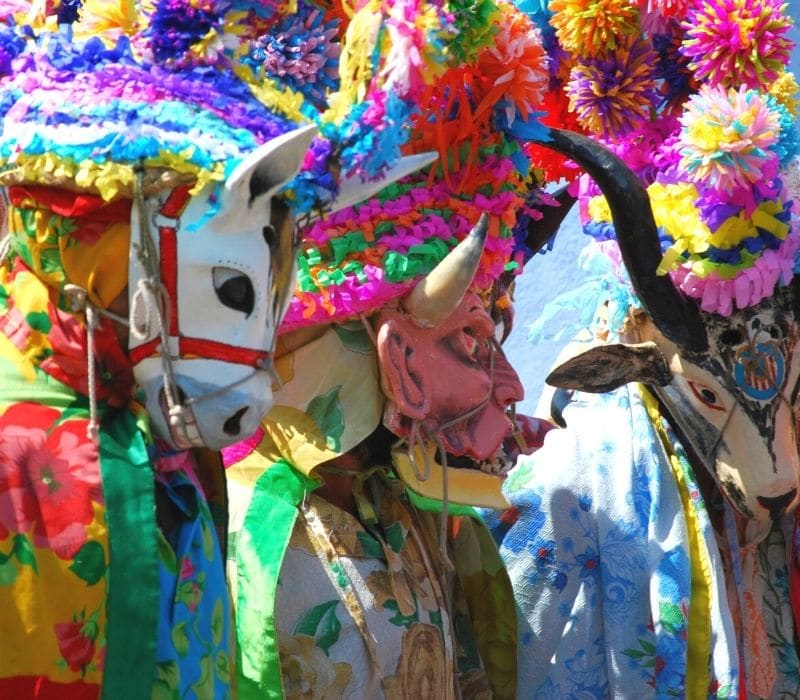
Carnival Traditions in Different Regions
Carnaval de Tlaxcala
The Carnaval de Tlaxcala in the state of Tlaxcala is known for its unique blend of pre-Hispanic and Catholic traditions. This carnival showcases ancient dances and rituals performed by indigenous communities in colorful traditional attire. The “Xochipitzahuac” dance, for example, pays tribute to the goddess Xochiquetzal, the deity of flowers and fertility. Another highlight of the Carnaval de Tlaxcala is the parade of the “toritos” (little bulls), where people wear bull-shaped costumes with fireworks attached, creating a dazzling display of sparks and lights. The Carnaval de Tlaxcala is a testament to the region’s rich cultural heritage and indigenous traditions.
Carnaval de Chiapa de Corzo
In the southern state of Chiapas, the Carnaval de Chiapa de Corzo takes place in the town of Chiapa de Corzo and dates back over 500 years. This carnival is known for its ancient dances, particularly the “Parachicos.” The Parachicos are male dancers who wear colorful costumes adorned with ribbons, bells, and masks and dance through the streets, symbolizing the triumph of good over evil. The dances are accompanied by live music, including marimbas, drums, and flutes. The Carnaval de Chiapa de Corzo is recognized as an Intangible Cultural Heritage by UNESCO and attracts visitors from around the world.
Carnaval de Huejotzingo
Located in the state of Puebla, the Carnaval de Huejotzingo is one of the most traditional and oldest carnivals in Mexico. This carnival is deeply rooted in the indigenous heritage of the region and combines pre-Hispanic and Catholic elements. The celebrations feature colorful parades, where participants wear traditional costumes and masks representing mythical creatures, animals, and historical figures. The dances performed during the Carnival de Huejotzingo, such as the “Danza de los Huehues” and the “Danza de los Chinelos,” pay homage to the region’s ancestral traditions and lore. The carnival also includes cultural exhibitions, concerts, and culinary events, providing a holistic experience of Mexican traditions.
Preserving and Promoting Carnival Traditions
Government Support and Funding
The Mexican government recognizes the importance of preserving and promoting the country’s vibrant carnival traditions. Various government entities provide financial support, grants, and incentives to carnival organizers, cultural organizations, and artists. These funds are used to maintain and restore traditional costumes, purchase musical instruments, create new floats, and organize educational workshops and seminars. The government’s support ensures that carnival traditions continue to thrive and that future generations have the opportunity to experience the joy and cultural significance of these celebrations.
Cultural Organizations and Festivals
Numerous cultural organizations and festivals across Mexico are dedicated to the preservation and promotion of carnival traditions. These organizations bring together carnival enthusiasts, cultural historians, artists, and performers to collaborate on projects, research, and educational initiatives. They organize carnivals, exhibitions, and workshops that highlight the diverse regional traditions and provide a platform for artists to showcase their talents. Through their efforts, these cultural organizations help keep the carnival traditions alive and ensure that they remain an integral part of Mexico’s cultural fabric.
Educational Initiatives
Education plays a crucial role in preserving and promoting Mexican carnival traditions. Schools, universities, and cultural institutions offer courses, workshops, and seminars that focus on the history, music, dance, and cultural significance of carnivals. These educational initiatives allow students and participants to develop a deeper understanding and appreciation for the diverse carnival traditions found throughout Mexico. They also foster creativity, cultural exchange, and a sense of pride in Mexican heritage. By equipping the younger generations with knowledge and skills, educational initiatives contribute to the continuity and evolution of Mexican carnival celebrations.
In conclusion, Mexican carnivals are a testament to the country’s rich history, cultural diversity, and creative spirit. From their pre-Hispanic origins to their fusion with Catholicism, Mexican carnivals have evolved into vibrant and cherished celebrations that showcase the unique regional cultures, music, dance, costumes, and delicious cuisine. The colorful costumes and masks, traditional music and dance performances, street parades and floats, and the religious significance and rituals all add to the allure and magic of carnival celebrations in Mexico. With the support of the government, cultural organizations, and educational initiatives, these traditions continue to be preserved and promoted, ensuring that Mexican carnivals remain a cherished part of the country’s cultural heritage for generations to come.
